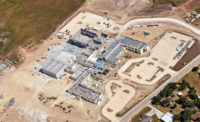Edison Mission Group's $500-million Walnut Creek Energy Park in the City of Industry is designed for those days when electricity consumption peaks or renewable-power sources refuse to play ball.
"Historically, peaking powerplants like Walnut Creek operate only when energy demand is highest," says Larry Kostrzewa, managing director, commercial management for Santa Ana-based Edison Mission Group, a unit of Edison International. "Say it's a hot summer daythe Santa Anas are blowing and everybody has their AC on. That's when these plants will get going."
The power provided to Southern California by the natural-gas-fired plant also will come in handy when energy from solar and wind sources is interrupted.
"As Los Angeles' power grid shifts to accommodate more wind and solar power, we'll see peaking plants like this fill in the gaps when clouds pass over solar fields or the wind drops off," Kostrzewa says.
Kiewit Power Constructors, Santa Fe Springs, is the engineering, procurement and construction contractor for the project, which broke ground in June. Walnut Creek will consist of five, 100-MW turbines, each 60 ft long by 20 ft wideabout the size of a double-wide office trailer. The turbines were manufactured by General Electric in Cincinnati and Houston.
Giant Muffler System
An emissions-control unit, which also serves as a kind of giant muffler system to attenuate sound, will stand 32 ft high and 52 ft long. According to Matt Scott, Kiewit vice president in charge of power construction operations in California, the unit will help the facility meet the South Coast Air Quality Management District's rigorous air-quality requirements.
The facility will use reclaimed water obtained from a street waterline in front of the property. A wastewater discharge tie-in will be located on site.
"The foundation work we do is a big part of the project and a big part of the engineering work that occurs," Scott says. "The foundation work and pile work is a very dynamic design process. There have been significant improvements in design features and construction methods over the past several years, and they're being employed here so the technology for the structural design is really all below ground, while the technology for power generation is all in the above-ground equipment."
The plant is designed to last about 20 years, according to Scott, and the plant's steel components are designed to hold up under seismic stress even at the end of the two-decade period. He says, "This poses significant design challenges because metal will wear over time and you still have to withstand earthquakes."
When completed in June 2013, the turbines will be capable of fully powering up in 10 minutes, putting 479 MW of electricity at the disposal of California's Independent System Operator. That's enough energy to power 165,000 residential central air conditioners, according to Edison.
"[The facility] is pretty much in the heart of the L.A. basin, smack in the center of what the grid operator calls the L.A. Basin West Local Reliability Area," Kostrzewa says. "From a power-grid standpoint, we import a lot of power in this area from out of state or from other parts of the state. But to keep the grid stable, about 40% has to be generated here."
Walnut Creek is designed for the grid operator to control it directly, ordering the plant to increase or reduce output, as needed.
According to Scott, the project posed significant challenges not only in meeting California's rigorous seismic construction standards, but also in the logistics of moving extremely heavy equipment and materials to and within a relatively small worksite.
"The size of the project area is less than 12 acres," he says. "That is a very small footprint for a project like this to be able to generate this kind of power."
Workers used specially designed trailers to haul the 400,000-lb turbines and other hefty equipment from GE's yards to the jobsitetraveling through city streets at night and with California Highway Patrol units in attendance.
Once at the site, Goldhofer trailers are used to move the equipment about. Scott describes the trailers as "resembling a giant caterpillar." They are capable of articulating all their wheels in one direction or another at the same time.
The site is located adjacent to a major Southern California Gas Co. natural-gas line, allowing operators to draw fuel as needed.
"We don't have to worry about where the gas is stored," Kostrzewa says. "It will come from a combination of interstate pipes coming into the state as well as storage that Southern California Gas operates."
He adds, "The physical flow is based on an aggregate, so it's not like we'll have to go cut a deal to buy quantities of gas from Texas and manage it all at once. There's a whole industry around matching gas flow and delivery and storage, and we'll let the people good at that do that."
As a peaking powerplant dependent on the vagaries of weather and the overall energy grid's demand patterns, Walnut Creek probably will operate between 10% to 20% of the year.
"On a not-so-hot day, you may not see this plant running," Kostrzewa says. "But there will always be someone there, always ready to run it. But it's not a base-load, round-the-clock operation."
The project's financing comes through a combination of Edison Mission Group's internal cash and a project finance loan, Kostrzewa says.
Commercial operation of the plant is expected to begin in June 2013 under a California Public Utilities Commission-approved power-purchase agreement with Southern California Edison.
Edison Mission Group says the project will create 220 construction jobs over two years.





Post a comment to this article
Report Abusive Comment